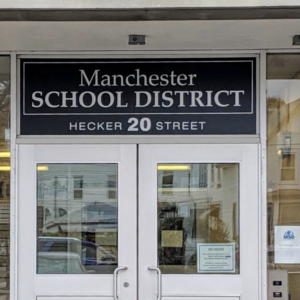On her way out the door, former Manchester Mayor Joyce Craig and her fellow Democrats approved a $290 million bond to fund new school construction across the district.
The question now is, who’s going to show up to attend them?
For years, Manchester enrollment has declined, even as spending has soared. But the impact of the COVID pandemic has contributed to a new problem: chronic absenteeism. Kids are enrolled, but they’re not showing up.
According to New Hampshire Department of Education data released this week, Manchester’s high school reported an 85.7 percent attendance rate for the 2022-2023 school year, among the lowest in the state.
Chronic absenteeism is when an individual student has at least 10 or more unexcused absences from school per year. The state average for high school attendance in the 2022-2023 school year was 90.8 percent, and the average for all grades was 92.3 percent.
Manchester’s total attendance for all grades was 89.2 percent.
(New Hampshire’s data does not differentiate excused absences from unexcused, leaving the public with just the rate of attendance.)
Manchester is hardly alone.
A new report from the American Enterprise Institute using data from 40 states and the District of Columbia estimates that 26 percent of public school students were chronically absent last school year, up from the pre-pandemic rate of 15 percent. This study defines chronic absenteeism as missing 10 percent of a school year, which is nearly a month of classroom instruction.
New Hampshire, with one of the best-educated states and top-performing education systems, isn’t seeing numbers as low as the national average. But attendance among Granite State students has declined, and Manchester Mayor Jay Ruais tells NHJournal city leaders know they need to do more to get kids in class.
“School attendance is critically important, particularly coming out of the pandemic and mitigating the learning loss experienced during these unprecedented times. The Manchester School District initiated an attendance campaign last summer, which has played an important role in increasing attendance in the schools,” Ruais said.
“We are not where we want or need to be, but by embedding attendance goals into the core objectives of every school, we are reaffirming our commitment to providing a supportive and conducive environment where every student has the opportunity to succeed academically.”
Student attendance took a major dip during the pandemic years, and while the rates in New Hampshire are improving, Manchester Superintendent Jennifer Chmiel Gillis said more is being done to get kids back into the classroom.
“In the last year, we hired a district-wide attendance coordinator and launched our Show Up Manchester attendance campaign,” Chmiel Gillis said. “Additionally, schools have built attendance improvement into their yearly goals. We are now starting to see the early fruits of these efforts between the district and schools, with attendance increasing at all grade levels. We have more work to do, but we are encouraged by the progress and will continue moving forward.”
Experts say the social isolation that was created by social media and boosted by extended school closings is fraying the social connections between children and making it easier for less-motivated students to stay home.
A similar dynamic may be at play in schools, where experts say strong relationships are critical for attendance.
“There is a sense of, ‘If I don’t show up, would people even miss the fact that I’m not there?'” Charlene M. Russell-Tucker, the commissioner of education in Connecticut, told The New York Times.
Jason Bedrick, a Research Fellow in the Center for Education Policy at The Heritage Foundation, told NHJournal that while the causes of the current crisis are complicated, the disastrous impact of COVID-related closure cannot be ignored.
“A significant factor is almost certainly the prolonged and unnecessary school closures that the teachers unions pushed. School closures sent the implicit message that attending school in person was not necessary. Putting the genie back in the bottle won’t be easy,” Bedrick said.
Data on private school attendance rates in New Hampshire is not available.
A representative for New Hampshire’s Department of Education told NHJournal that public school attendance is once again heading in the right direction. A decade before COVID, the state’s schools averaged 95 percent attendance. In the 2021-22 school year, it fell to of 90.8 percent. Now attendance is up to 92.3 percent — a marked improvement.
“Following an academic period when respiratory illnesses often resulted in above-average absences, attendance in New Hampshire’s public classrooms are not only steady but strongly improving,” the representative said.
But in Manchester that year, attendance fell to 87 percent, and among high school students, it was a dismal 82.4 percent.
And, critics say, the Manchester School Board didn’t help matters last November when it changed school policy and ended the practice of giving a “no grade” to high school students who have five or more unexcused absences in a class they are passing.
“There are parents who take their children out of school to go away on vacations or to go for an extended period of time back to their home country, and think it is acceptable for their child to have missed school for days or weeks with no consequence,” school board member John Avard said at the time.



